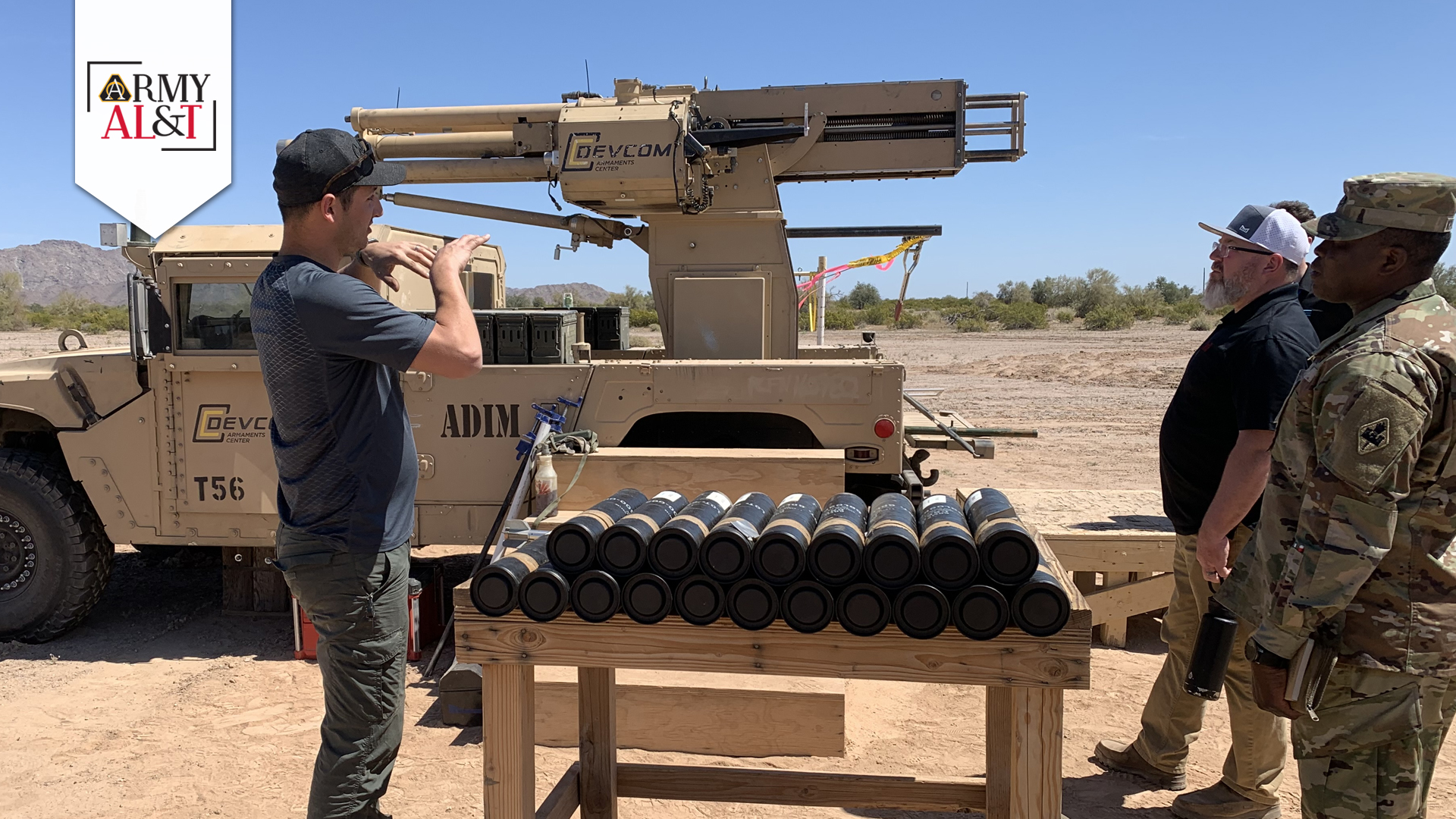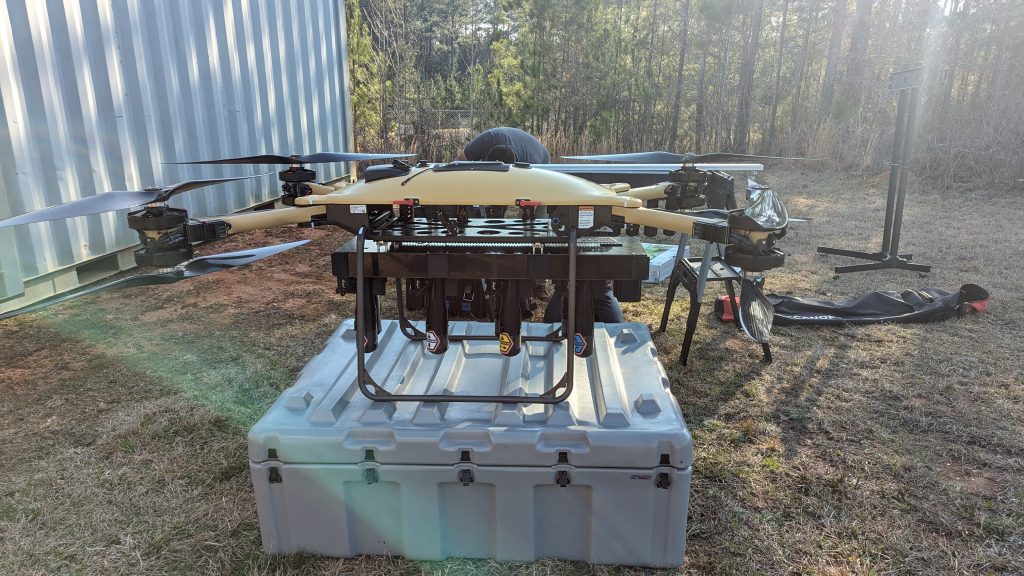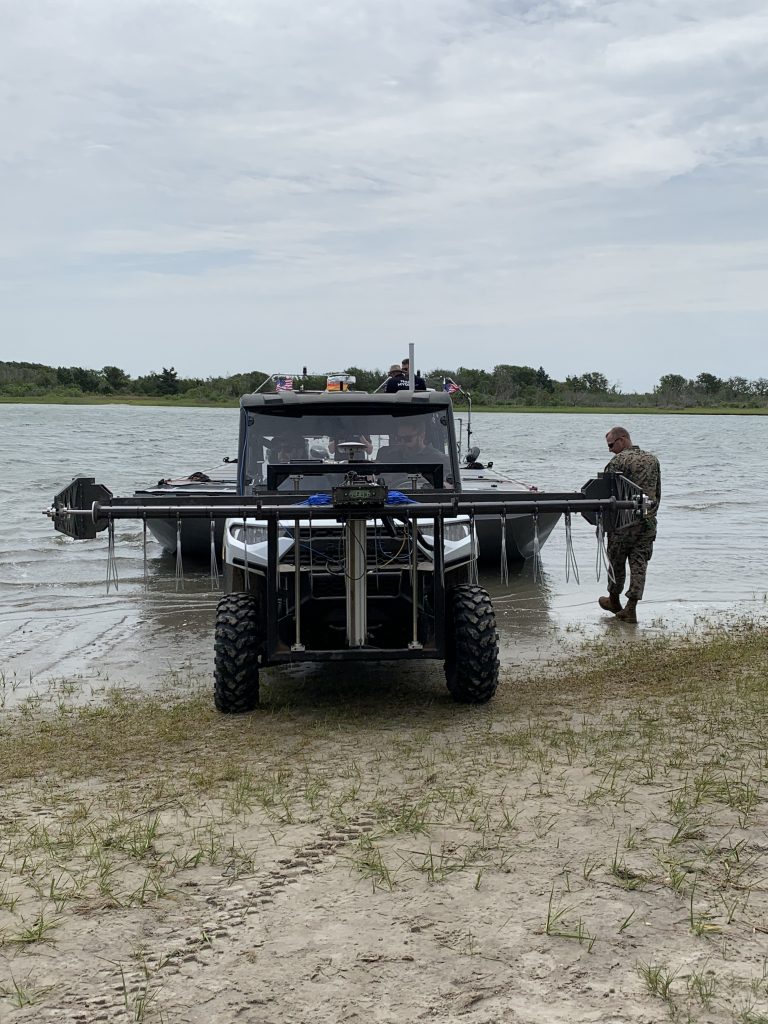
GOBLN ON DECK: The GOBLN neutralization subsystem is tested during one of the program’s touch points at Yuma Proving Ground, Arizona. The system is designed to evaluate developing technologies and strengthen relationships with industry and other government partners. (Photo by Maj. Thomas Fite, PM CCS)
Maximizing results and minimizing risk in a fiscally constrained environment through cumulative testing and industry observations.
by Maj. Thomas Fite and Amit Makhijani
For a project in its early stages with budget limits and extensive prototyping, it’s crucial to use funds wisely and minimize risks as much as possible before key project milestones to enable overall success. Using cumulative testing and observing industry-led demonstrations can prove to be an effective strategy in achieving this goal.
Cumulative testing allows for the continuous improvement and refinement of designs and maintaining focus on user needs and requirements while optimizing resource allocation. Observing industry-led demonstrations offers several benefits, including leveraging commercial resources, fostering collaboration and validating practicality of new technologies from industry’s internal investment. In all cases, the critical factor for success is open and candid communication with all stakeholders.
The XM123 Ground Obstacle Breaching Lane Neutralizer (GOBLN) team incorporated cumulative testing and industry demonstrations into the program’s test and evaluation (T&E) strategy during the Technology Maturation and Risk Reduction (TMRR) Phase of the program, and used this approach to help tailor the program’s touch points and early user assessments (EUA). The program team is now using the approach to help translate desired characteristics for the Abbreviated Capability Development Document (A-CDD) into measurable performance requirements.
CUMULATIVE TESTING: DEFINITION AND BENEFITS
Cumulative testing involves breaking the development and testing process into small, manageable and measurable increments. Each increment focuses on a specific functionality or feature, which is tested and evaluated before moving on to the next increment. For a complex system, or system of systems, each increment could represent a major subsystem or design feature. As testing progresses, knowledge gained from previous increments is incorporated (i.e., subsystems are integrated and tested together) until the design is sufficiently mature to move onto the next major milestone or test event.
The main goal of cumulative testing in a fiscally constrained environment is to deliver the best possible capability to the warfighter while optimizing resource allocation. This approach ensures that capabilities and prototyping meet the needs and requirements of the user and fall within budget limitations. The benefits are numerous.
First, by testing and evaluating each increment, potential issues can be identified and addressed at an early stage. This prevents the accumulation of problems that may be difficult and costly to rectify later in the development process. Second, cumulative testing allows for adjustments and modifications to be made based on user feedback through engineering tests and subsystem-specific touch points. Capabilities are tailored to the specific needs, preferences and anticipated requirements of the warfighter, maximizing their effectiveness and usability. Third, by focusing on specific increments, resources can be allocated earlier to higher-risk areas, maximizing the impact of limited resources. Fourth, cumulative testing facilitates continuous improvement throughout the development cycle. Feedback from testing each increment or subsystem can be incorporated into subsequent iterations, resulting in a refined, high-quality product for the end user. Finally, breaking the process and the system into smaller pieces reduces the risk of large-scale failures.
Issues identified in one increment or subsystem can be resolved before moving onto the next, minimizing the impact on the overall program schedule and budget while maximizing results. However, carrying out continuous improvement to reach toward a perfect solution may lead to what is called “the acquisition valley of death.” This occurs when too many resources have been focused on maturing technologies or pursuing design improvements, and not enough future resources have been allocated to move the program into the next phase of the acquisition life cycle. Attempting to improve the design can slow a program’s forward momentum, which in turn reduces prioritization of funding for the program. Potential materiel solutions languish in this valley of death until future resources become available.

DETECT AND NEUTRALIZE: GOBLN team members attend an industry demonstration of alternate neutralization technologies in Opelika, Alabama, in February 2024. (Photo by Maj. Thomas Fite, PM CCS)
LEVERAGING INDUSTRY-LED DEMONSTRATIONS
In a budget-constrained environment, it is important to leverage all available resources, including internal industry investment for resourced maturation of technologies and demonstrations. This strategic approach can advance technology and help inform future program requirements without significant use of Army resources. By tapping into industry expertise, infrastructure and resources, programs can benefit from access to state-of-the-art facilities, cutting-edge technologies and a wealth of experienced professionals. This collaboration not only accelerates the development of innovative solutions but also enhances their reliability and effectiveness. Additionally, by adopting this strategy, Army program stakeholders can effectively communicate with industry partners regarding desired requirements and capabilities.
XM123 GOBLN T&E STRATEGY
Developed by Project Manager Close Combat Systems (PM CCS) within the Joint Program Executive Office for Armaments and Ammunition, the XM123 GOBLN is a mine- and obstacle-clearing system designed to maintain a high operations tempo by clearing non-explosive and explosive obstacles. It will improve deployment speed, force protection and survivability and allow warfighters to execute penetration, disintegration and exploitation in close and deep maneuver areas.
From its inception in 2020, the XM123 GOBLN program has focused on a strategy of cumulative testing and observing industry investments: maturing subsystems individually, observing options from industry and formulating an objective system that will eventually be brought together for a concept assessment. GOBLN’s prototype testing was planned to be cumulative, so that knowledge gained from testing builds upon itself and is incorporated in subsequent test events. Additionally, the GOBLN team has actively engaged with industry, observing industry- and government-sponsored events.
For example, the team traveled to Grassobbio, Italy, last fall to participate in a demonstration of Tesmec’s ground penetrating radar technology. During the Tesmec-sponsored event, the company set up its own minefield and successfully showcased its technology while also highlighting the work that remains for the system to be fully functional. This demonstration clearly showed the current state of the technology and what the baseline requirement could be for buried detection. Additionally, the team recently traveled to Fort Moore, Georgia, to participate in the Army Expeditionary Warrior Experiment 2024, hosted in February by the Maneuver Battle Lab. At the event, the XM123 GOBLN team had the opportunity to engage with industry partners on emerging technology, such as unmanned aerial systems (UAS) delivering kinetic, lethal payloads. The recent events in Eastern Europe have shown the importance and value of UASs as hunter-killers, including their role in breaching operations. Since program inception in 2020, our team has led 16 of its own tests and participated in more than 30 industry and service demonstrations of supporting technologies. The TMRR effort will culminate with a EUA in 2024 where a fully integrated capability of government- and industry-provided solutions will be demonstrated before a Milestone B decision.

DETECT AND NEUTRALIZE: GOBLN team members attend an industry demonstration of alternate neutralization technologies in Opelika, Alabama, in February 2024. (Photo by Maj. Thomas Fite, PM CCS)
KEEPING INDUSTRY ENGAGED
From the XM123 GOBLN program’s inception, resource limitations have driven the program acquisition strategy and timeline. To overcome those limitations, the XM123 GOBLN team prioritized open and frequent communication through Industry Day events, opening communication lines with all stakeholders, conducting regularly scheduled meetings and establishing feedback mechanisms to generate and maintain industry interest. Since the program’s formal initiation, the team has executed three Industry Day events and hosted three industry engagements at prototype tests. Industry Day events allow program personnel to engage with potential materiel solution vendors, provide them with insights on the program’s goals, requirements and potential opportunities for investments and help them understand existing risks and limitations. These events also allow industry to have a dialog with the user and acquisition communities to ask questions, understand user needs and express any concerns.
A second avenue that the XM123 GOBLN team adopted is to open the communication lines between all stakeholders: transparency is the key to success. Regularly sharing updates, progress reports and any relevant information helps maintain trust and interest. The program keeps communication channels wide open with industry partners and stakeholders. Although it requires extra time to answer questions, the relationships formed and data exchanged during both industry and program resource demonstrations have been highly valuable, helping to shape system requirements and informing users on technical feasibility.
A third communication avenue that has proven effective for our team is through regular scheduling of tag-ups. These scheduled meetings with industry partners and stakeholders provide a structured forum for discussing progress and challenges and addressing any issues. These regular check-ins keep everyone on the same page and facilitate collaborative problem-solving. Additionally, tag-ups enable the team and our industry partners to adapt and respond to changing priorities, which is incredibly important in a fiscally constrained environment.
Finally, the team has established feedback mechanisms that allow stakeholders to provide input, voice concerns and contribute to the program’s evolution. This iterative process ensures the program remains relevant and responsive to stakeholder needs. Col. Russell Hoff, former project manager for PM CCS, said it best at program initiation: “Industry involvement is paramount to a program’s success, and effective communication and engagement is the foundation.” The XM123 GOBLN program has followed his guidance. During any engagement with industry, planned or unplanned, feedback is listened to, recorded and incorporated as the program moves forward.
CUMULATIVE KNOWLEDGE SUPPORTS EUA
In addition to observing more than 30 different technology demonstrations and conducting 16 different engineering tests, the program also conducted three touch points at the sub-system level. These events play a crucial role in the cumulative knowledge roll-up in support of the program’s cumulative EUA, where an integrated capability will be demonstrated along with demonstrations from industries. To communicate the intent of this event, the team hosted an Industry Day at Picatinny Arsenal, New Jersey, in January 2024. More than 140 representatives from 49 companies and 15 government organizations attended. Participants received a classified briefing on breaching and a program update brief, participated in one-on-one break-out sessions and received guidance on how to participate in the upcoming EUA. Both government and industry partners will have an opportunity to demonstrate candidate system or subsystem technology solutions that will provide the warfighter with the ability to detect and neutralize surface-laid and buried threats at stand-off. The technology demonstrated will help translate A-CDD desired characteristics to measurable requirements that can be used in developing the full Capability Development Document. In addition, it will help shape the acquisition approach for the Engineering and Manufacturing Development Phase. Leading up to the event, the XM123 GOBLN team will continue evaluating potential concepts, attend industry-led demonstrations and regularly host tag-ups with industry partners and the user community.

BENEATH THE SURFACE: The U.S. Marine Corps conducts a live demonstration of its semi-autonomous subsurface detection technology at Camp Lejeune, North Carolina, in June 2023. (Photo by Maj. Thomas Fite, PM CCS)
CONCLUSION
Navigating a fiscally constrained environment in the early stages of a project demands strategic allocation of resources and a keen focus on risk mitigation to ensure success. By continuously refining designs, incorporating user feedback and optimizing resource allocation, cumulative testing enhances the efficiency of the development cycle and ensures the capability meets user needs while staying within budget constraints. Leveraging industry-led demonstrations offers a strategic advantage by tapping into external expertise, infrastructure and resources. This collaboration accelerates innovation, enhances reliability and helps inform future program requirements, ultimately bolstering the project’s success.
The XM123 GOBLN program shows how blending cumulative testing with industry observations boosts its T&E efforts. Fostering open communication, involving stakeholders through Industry Days and regular tag-ups and setting up feedback loops to stay in sync with user needs and technical capabilities is supporting planning for the next phase of acquisition. The XM123 GOBLN program serves as a testament to the efficacy of this approach, highlighting how it fosters innovation, mitigates risks and is actively working toward delivering a capability tailored to meet the demands of the end user.
For more information on an A-CDD, go to https://aaf.dau.edu/.
For more information on prototype experimentation, go to https://aaf.dau.edu/aaf/mca/prototyping/.
MAJ. THOMAS FITE is an assistant product manager for PPM CCS. He holds an MBA in systems engineering from the University of Alabama in Huntsville, a Master of Public Affairs from the University of Missouri and a B.A. in political science from the University of Iowa. He is a DAWIA Certified Practitioner in program management.
AMIT MAKHIJANI is a project officer for PM CCS with more than 20 years of government service in engineering and project management. He holds an M.S. in Management and an MBA, both from the Florida Institute of Technology, and a B.S. in computer engineering from the New Jersey Institute of Technology. He is DAWIA Certified Advanced in program management and a Practitioner in engineering and technical management.







